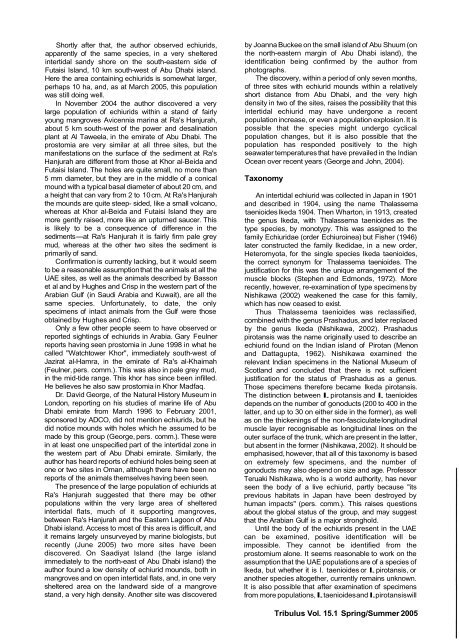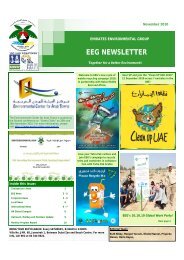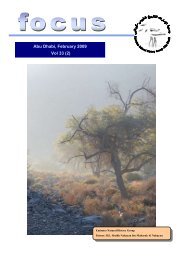Oman (Lepidoptera: Pieridae) - Al Ain Chapter, Emirates Natural ...
Oman (Lepidoptera: Pieridae) - Al Ain Chapter, Emirates Natural ...
Oman (Lepidoptera: Pieridae) - Al Ain Chapter, Emirates Natural ...
Create successful ePaper yourself
Turn your PDF publications into a flip-book with our unique Google optimized e-Paper software.
Shortly after that, the author observed echiurids,<br />
apparently of the same species, in a very sheltered<br />
intertidal sandy shore on the south-eastern side of<br />
Futaisi Island, 10 km south-west of Abu Dhabi island.<br />
Here the area containing echiurids is somewhat larger,<br />
perhaps 10 ha, and, as at March 2005, this population<br />
was still doing well.<br />
In November 2004 the author discovered a very<br />
large population of echiurids within a stand of fairly<br />
young mangroves Avicennia marina at Ra's Hanjurah,<br />
about 5 km south-west of the power and desalination<br />
plant at <strong>Al</strong> Taweela, in the emirate of Abu Dhabi. The<br />
prostomia are very similar at all three sites, but the<br />
manifestations on the surface of the sediment at Ra's<br />
Hanjurah are different from those at Khor al-Beida and<br />
Futaisi Island. The holes are quite small, no more than<br />
5 mm diameter, but they are in the middle of a conical<br />
mound with a typical basal diameter of about 20 cm, and<br />
a height that can vary from 2 to 10 cm. At Ra's Hanjurah<br />
the mounds are quite steep- sided, like a small volcano,<br />
whereas at Khor al-Beida and Futaisi Island they are<br />
more gently raised, more like an upturned saucer. This<br />
is likely to be a consequence of difference in the<br />
sediments-at Ra's Hanjurah it is fairly firm pale grey<br />
mud, whereas at the other two sites the sediment is<br />
primarily of sand.<br />
Confirmation is currently lacking, but it would seem<br />
to be a reasonable assumption that the animals at all the<br />
UAE sites, as well as the animals described by Basson<br />
et al and by Hughes and Crisp in the western part of the<br />
Arabian Gulf (in Saudi Arabia and Kuwait), are all the<br />
same species. Unfortunately, to date, the only<br />
specimens of intact animals from the Gulf were those<br />
obtained by Hughes and Crisp.<br />
Only a few other people seem to have observed or<br />
reported sightings of echiurids in Arabia. Gary Feulner<br />
reports having seen prostomia in June 1998 in what he<br />
called "Watchtower Khor", immediately south-west of<br />
Jazirat al-Hamra, in the emirate of Ra's al-Khaimah<br />
(Feulner, pers. comm.). This was also in pale grey mud,<br />
in the mid-tide range. This khor has since been infilled.<br />
He believes he also saw prostomia in Khor Madfaq.<br />
Dr. David George, of the <strong>Natural</strong> History Museum in<br />
London, reporting on his studies of marine life of Abu<br />
Dhabi emirate from March 1996 to February 2001,<br />
sponsored by ADCO, did not mention echiurids, but he<br />
did notice mounds with holes which he assumed to be<br />
made by this group (George, pers. comm.). These were<br />
in at least one unspecified part of the intertidal zone in<br />
the western part of Abu Dhabi emirate. Similarly, the<br />
author has heard reports of echiurid holes being seen at<br />
one or two sites in <strong>Oman</strong>, although there have been no<br />
reports of the animals themselves having been seen.<br />
The presence of the large population of echiurids at<br />
Ra's Hanjurah suggested that there may be other<br />
populations within the very large area of sheltered<br />
intertidal flats, much of it supporting mangroves,<br />
between Ra's Hanjurah and the Eastern Lagoon of Abu<br />
Dhabi island. Access to most of this area is difficult, and<br />
it remains largely unsurveyed by marine biologists, but<br />
recently (June 2005) two more sites have been<br />
discovered. On Saadiyat Island (the large island<br />
immediately to the north-east of Abu Dhabi island) the<br />
author found a low density of echiurid mounds, both in<br />
mangroves and on open intertidal flats, and, in one very<br />
sheltered area on the landward side of a mangrove<br />
stand, a very high density. Another site was discovered<br />
by Joanna Buckee on the small island of Abu Shuum (on<br />
the north-eastern margin of Abu Dhabi island), the<br />
identification being confirmed by the author from<br />
photographs.<br />
The discovery, within a period of only seven months,<br />
of three sites with echiurid mounds within a relatively<br />
short distance from Abu Dhabi, and the very high<br />
density in two of the sites, raises the possibility that this<br />
intertidal echiurid may have undergone a recent<br />
population increase, or even a population explosion. It is<br />
possible that the species might undergo cyclical<br />
population changes, but it is also possible that the<br />
population has responded positively to the high<br />
seawater temperatures that have prevailed in the lndian<br />
Ocean over recent years (George and John, 2004).<br />
Taxonomy<br />
An intertidal echiurid was collected in Japan in 1901<br />
and described in 1904, using the name Thalassema<br />
taenioides lkeda 1904. Then Wharton, in 1913, created<br />
the genus Ikeda, with Thalassema taenioides as the<br />
type species, by monotypy. This was assigned to the<br />
family Echiuridae (order Echiuroinea) but Fisher (1946)<br />
later constructed the family Ikedidae, in a new order,<br />
Heteromyota, for the single species lkeda taenioides,<br />
the correct synonym for Thalassema taenioides. The<br />
justification for this was the unique arrangement of the<br />
muscle blocks (Stephen and Edmonds, 1972). More<br />
recently, however, re-examination of type specimens by<br />
Nishikawa (2002) weakened the case for this family,<br />
which has now ceased to exist.<br />
Thus Thalassema taenioides was reclassified,<br />
combined with the genus Prashadus, and later replaced<br />
by the genus lkeda (Nishikawa, 2002). Prashadus<br />
pirotansis was the name originally used to describe an<br />
echiurid found on the lndian island of Pirotan (Menon<br />
and Dattagupta, 1962). Nishikawa examined the<br />
relevant lndian specimens in the National Museum of<br />
Scotland and concluded that there is not sufficient<br />
justification for the status of Prashadus as a genus.<br />
Those specimens therefore became lkeda pirotansis.<br />
The distinction between I. pirotansis and I. taenioides<br />
depends on the number of gonoducts (200 to 400 in the<br />
latter, and up to 30 on either side in the former), as well<br />
as on the thickenings of the non-fasciculate longitudinal<br />
muscle layer recognisable as longitudinal lines on the<br />
outer surface of the trunk, which are present in the latter,<br />
but absent in the former (Nishikawa, 2002). It should be<br />
emphasised, however, that all of this taxonomy is based<br />
on extremely few specimens, and the number of<br />
gonoducts may also depend on size and age. Professor<br />
Teruaki Nishikawa, who is a world authority, has never<br />
seen the body of a live echiurid, partly because "its<br />
previous habitats in Japan have been destroyed by<br />
human impacts" (pers. comm.). This raises questions<br />
about the global status of the group, and may suggest<br />
that the Arabian Gulf is a major stronghold.<br />
Until the body of the echiurids present in the UAE<br />
can be examined, positive identification will be<br />
impossible. They cannot be identified from the<br />
prostomium alone. It seems reasonable to work on the<br />
assumption that the UAE populations are of a species of<br />
Ikeda, but whether it is I. taenioides or I. pirotansis, or<br />
another species altogether, currently remains unknown.<br />
It is also possible that after examination of specimens<br />
from more populations, I. taenioides and I. pirotansis will<br />
Tribulus Vol. 15.1 Spring/Summer 2005




